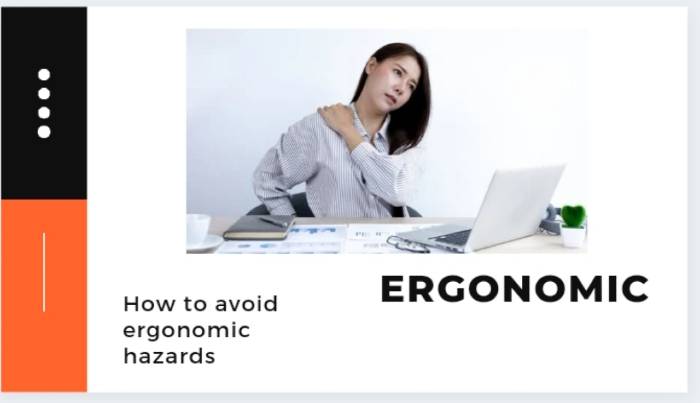What are ergonomic hazards? the risk of musculoskeletal disorder (MSD) due to the forced posture, continuous application of force, repetitive movement, and manual handling of loads in the workplace.
On the other hand, musculoskeletal disorders are alterations suffered by body structures such as mmuscles tendons, joints, bones, nerves,, and the circulatory system due to work or the environment in which it develops.
Ergonomics is the science of designing and organizing things so that people will interact with the environment more effectively and safely. Ergonomics means organizing the environment to suit the person. Factors contributing to its ergonomic design include
- The duration of the applied force of pushing, pulling, liflifting o,r grasping
- The amount of force exerted or the weight of the load
- The posture, reach a,n d ,gra,sp positions of a person
- Heights and distances to work surfaces, materials, and supplies
- Age, height, weight, physical ability
Ergonomic risks are those characteristics or working conditions that can seriously affect the health of workers, leading to the appearance of injuries (musculoskeletal or mental), occupational diseases, as well as other pathologies.
Generally, they are associated with the development of repetitive activities or that involve physical overexertion, but they are really present in any type of work (even in an office, since the simple fact of sitting more than 6 hours in front of a computer also makes a dent in health).
Ergonomic risks directly affect employee productivity, thereby reducing the competitiveness and profitability of the company. For this reason, and for the health of all, it is so important that you get down to work to prevent its appearance in your company.
What ergonomic risks are there?
As with occupational hazards, there are a multiplicity of ergonomic risks, and they are classified according to the activity carried out, and the environment where it takes place:
Ergonomic risks derived from forced postures
Who hasn't stooped down for a few minutes and had a hard time getting up? If you are young, you will probably last a few minutes longer than me, but you will end up noticing that pull in your lower back.
This is because we have made a posture with which our body does not feel comfortable, and it suffers. Well, imagine having to be developing your work activity in that position.
To identify whether the postural nature in which the work activity takes place can have consequences on the health of workers, you must analyze:
● The duration of the pose
● The frequency of movements
● What type of posture is it: neck, trunk, etc.
Ergonomic risks due to repetitive movements.
Carrying out the same movement for hours can overstress the muscles involved in the task, as well as the tendons and joints.
This fact can lead to injuries as important as tendinitis, osteoarthritis, arthritis, etc. The risk factors that can promote and increase the appearance of these lesions are:
● The duration of the repetitive motion
● The frequency of movements
● Recovery times between movements
● The use of force
Ergonomic risks in manual handling of loads.
However, it is the one that usually produces the most incidents for the sake of the physical overexertion that, many times, the workers must carry out. In this case, the risk factors will depend on whether the activity consists of lifting, moving, or shifting loads.
Risk of manual lifting of loads
The manual lifting of loads consists of picking up one or more objects -whose weight is greater than 3 kg-, to leave them inthemnother place or position.
Considering various parameters (such as the duration of the lift, the frequency with which it is performed, or the posture adopted by the worker) can genee a serious risk to their health, leading to the appearance of musculoskeletal problems.
Risk of manual transport of loads
The manual transport of loads refers to when you must walk for at least one meter, holding a load greater than 3 kg. This risk can cause the appearance of fatigue, tiredness, as well as musculoskeletal disorders.
Risk of manual pushing or pulling of loads
The manual push or traction is identified with the human force that is required to displace or move something on a surface. While the "push" refers to the force that the worker exerts when "pushing" a load, traction attends to when the worker "must use force" to pull the object towards him.
How to avoid ergonomic hazards
Stretch your muscles every day before you start working out. Know your physical limitations. Do not attempt the activities when the work environment is not suitable for you.
You may like
Back and legs
Have the materials and supplies raised at the waist level so that flex is minimized? This will help prevent lower back sprains and pulled hamstrings. If flexion is required, bend your knees and use your leg muscles to raise and lower your body. It is common in office environments and tight spaces. Move the keyboards away and down to a place where the arms are relaxed and extended.
Always ask for help if the load is too heavy or difficult to handle. When working with power tools or other handheld objects, avoid situations. Where the wrist bends. Arm strength should be pointing down or outward. Carry loads close to the body with a clear line of sight to the path. Avoid carrying loads off the waist or arriving for extended periods.
Avoid using tools that vibrate continuously or aggressively, or that take a long time to prick or grip. Use only the force necessary to get the job done. Alternate tasks and take a break from tasks during the workday to avoid vibrations for too long a duration.
Eyes and neck
Work so that your neck is not bent or tense. Make sure there is adequate lighting in the work areas. If the machines, tools, and workflow are misdesigned, they can cause excessive pressure on tendons, muscles, and nerves. Additionally, extreme temperatures can aggravate or increase ergonomic stress.
Your ability to recognize ergonomic problems on the construction site is the essential first step in correcting these problems and improving the safety and health of construction workers.
Presenter Tips
Pre-reading the Discussion Toolbox. Your comfort and confidence level will be higher if you know your subject. Discuss the related tasks, work areas, or events that make the Discussion Toolbox relevant to your workplace.
Involve workers through questions and input that leads to discussion.



